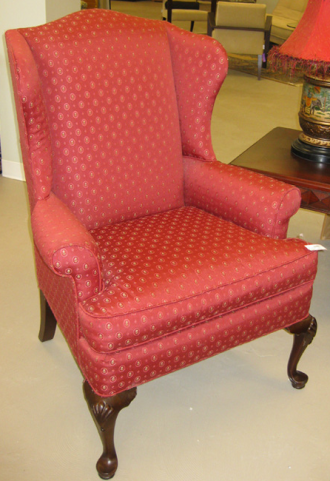
Wing chairs are sometimes called fireside chairs, and for good reason. Their design is perfect for enjoying the warmth of a fire while your back and sides are protected from chilly draughts.
These chairs were not the earliest furniture to use this approach to keeping warm. Wings were also used on some of the high-backed wooden settles (benches) found in English manor houses and inns long before the new kind of upholstered chair brought an extra level of comfort to the late 17th century. We now know these as wing or wingback chairs.
The same chairs soon appeared in colonial America. Like other Queen Anne furniture of the early 1700s, they had cabriole legs and curving lines that distinguished them from earlier styles. The famous cabinet-makers of the age, like Chippendale in London, designed elegant frames to set off the upholstery.
The picture of a wing chair stripped back by museum curators reveals that early padding was not as generous as we expect from a modern armchair. Fabrics were often vividly coloured. Bright patterns were seen in both colonial and Georgian drawing rooms. Restorers of 18th century antiques often favour plain colours, but this is not necessary for authenticity. Leather upholstery is also an option.

If you look at antique French wing chairs, or other chairs echoing the Louis XV or Louis XV period, you may see a lower seat in the bergère style. Similarly, in 18th century England Hepplewhite tried lowering the seat in his designs. He called the wings saddle-cheeks, perhaps knowing that they were called cheeks (joues), not wings, in France. Ears is their other name, used in some parts of Europe, German Ohrensessel for example, and remembered in the old-fashioned British name lug chair. (Lug meant ear.)
American wing chairs, also called easy chairs, were considered suitable as bedroom furniture for anyone frail or tired, sitting quietly in their room. Both antique and modern wing chairs may be associated with elderly people; a firm seat and a back with built-in draught-proofing offer an appropriate kind of comfort, and remind us that another name for this piece of furniture is grandfather chair.
In Britain, wing chairs were thought of as essential for a comfortable living room or parlour. Victorian writers describing scenes of idealised family life round a blazing hearth often mentioned a fireside chair. 19th century chairs were often more generously padded than earlier wingbacks – sometimes with a very firm horsehair stuffing.

Contemporary designers now produce all sorts of shapes and sizes of wing chair. Some blend the wingback concept with cutting-edge contemporary design, and yet the early Queen Anne shape has an enduring popularity. If you want a true antique, remember that “Queen Anne style” is just that: a style and not a promise that a chair is 300 years old.
Photos
Photographers credited in captions. Links to originals here: Red wing chair. New England wing chair with stripped back upholstery, Contemporary black wing chair.
Hi there,
we are developing a new Queen Anne style chair for our business and I wondered if we could add a link on our website to you brilliant description of the Wing Chairs? Just the text…
Kind regards,
Grahame Jenkins – MD
LikeLike
I have a queen ann chair with the peacock pattern on it.can someone tell me what it worth thank u
LikeLike